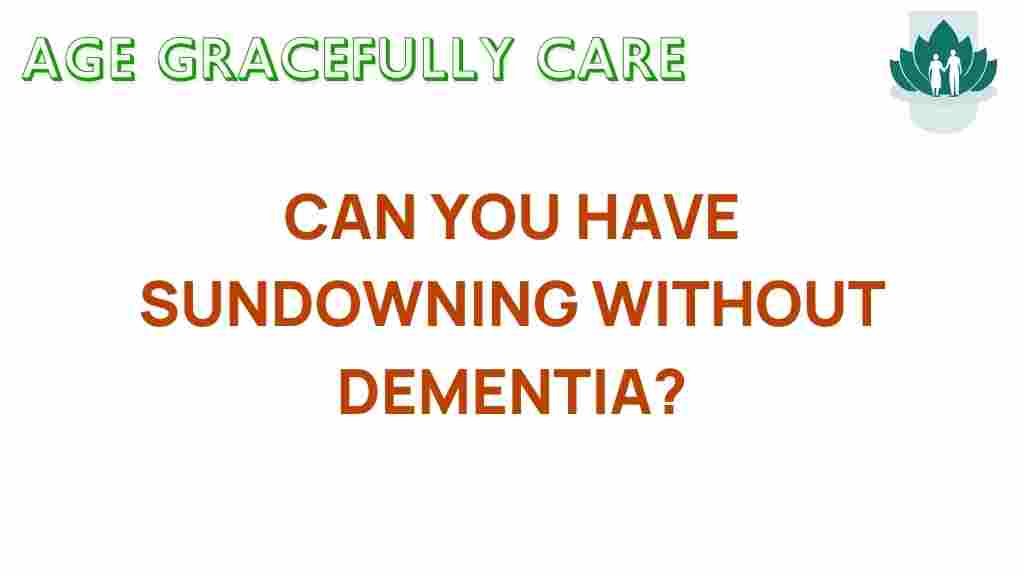The Surprising Reality of Sundowning: Is Dementia Necessary?
Sundowning is a term that describes a pattern of increased confusion, agitation, and behavioral symptoms that occur in the late afternoon and evening. This phenomenon is commonly associated with dementia, particularly in the elderly. Understanding the link between sundowning and dementia can help caregivers and family members better manage the mental health challenges that arise during the aging process.
Understanding Sundowning and Its Connection to Dementia
Sundowning can be particularly distressing for both the elderly individuals experiencing these symptoms and their caregivers. The symptoms typically emerge as the sun sets, leading to a troubling twilight zone where cognitive decline becomes more pronounced. The following factors may contribute to the onset of sundowning:
- Cognitive decline: The brain’s ability to process information deteriorates, leading to confusion.
- Fatigue: As the day progresses, the elderly may become more tired, which can exacerbate behavioral symptoms.
- Environmental factors: Changes in lighting and routine can trigger anxiety and disorientation.
- Loss of structure: Evening hours often lack the structured activities that help provide stability during the day.
Behavioral Symptoms of Sundowning
The behavioral symptoms associated with sundowning can vary widely among individuals, but commonly include:
- Increased confusion and disorientation
- Agitation and irritability
- Restlessness or pacing
- Wandering or attempting to leave the home
- Verbal outbursts or yelling
Recognizing these symptoms is essential for caregivers to implement appropriate care strategies. Understanding the emotional and mental health impact of these behaviors can also foster a compassionate approach to care.
Effective Care Strategies for Managing Sundowning
While sundowning is often associated with dementia, it is not an inevitable part of aging. There are several effective care strategies that can help mitigate the symptoms:
1. Establish a Routine
Creating a consistent daily routine can provide structure and comfort for elderly individuals. Regular meal times, activities, and bedtime can help reduce confusion and anxiety.
2. Maintain a Calm Environment
Minimize noise and light changes in the evening. Soft lighting and quiet surroundings can help create a more peaceful atmosphere, reducing agitation.
3. Encourage Daytime Activities
Engaging in physical and mental activities during the day can help improve overall mood and reduce fatigue by the evening. Consider:
- Walking or light exercise
- Puzzles or games
- Social interactions with family and friends
4. Monitor Diet and Hydration
A balanced diet and adequate hydration can significantly impact mental health. Avoid caffeine and sugar in the late afternoon and evening, as these can contribute to restlessness.
5. Use Soothing Techniques
Incorporating calming techniques can help ease the transition into the evening. Consider:
- Listening to soft music
- Practicing relaxation exercises
- Engaging in gentle stretching or yoga
Step-by-Step Process for Managing Sundowning
Here is a step-by-step approach caregivers can take to manage sundowning symptoms effectively:
Step 1: Observe and Document
Keep a diary of the individual’s behavior during the late afternoon and evening hours. Note patterns and triggers that may contribute to sundowning.
Step 2: Adjust the Environment
Make changes to the living space to create a calming atmosphere. This may include dimming lights, reducing noise, and creating a cozy area for relaxation.
Step 3: Implement Routine Changes
Work on establishing a daily routine that includes structured activities and rest periods. Aim to keep evenings low-key and predictable.
Step 4: Communicate and Engage
Maintain open lines of communication. Engaging the elderly individual in conversations and familiar activities can provide comfort and reduce feelings of isolation.
Step 5: Seek Professional Help
If sundowning symptoms persist or worsen, consult a healthcare professional for further advice and potential treatment options. This may include medication or therapy to address underlying mental health issues.
Troubleshooting Tips for Caregivers
Even with the best strategies in place, sundowning can still present challenges. Here are some troubleshooting tips for caregivers:
- Stay patient: Understand that these behaviors are a manifestation of the individual’s cognitive decline.
- Use distraction: Redirect attention to a favorite activity or memory to help ease agitation.
- Maintain a calm demeanor: Your response can influence the individual’s behavior; stay calm and reassuring.
- Connect with support groups: Sharing experiences with others in similar situations can provide valuable insights and encouragement. Consider visiting support resources for caregivers.
Conclusion: Is Dementia Necessary for Sundowning?
The surprising reality of sundowning reveals that while it is commonly associated with dementia, it is not an inevitable outcome of aging. By implementing effective care strategies and understanding the root causes of behavioral symptoms, caregivers can significantly improve the quality of life for elderly individuals. Mental health during the aging process is crucial, and with the right tools and support, caregivers can navigate the twilight zone of sundowning with compassion and effectiveness.
Ultimately, the journey through dementia and sundowning can be managed with appropriate care strategies, patience, and understanding. It is essential to remember that while sundowning may present challenges, it does not define the entirety of an individual’s experience with aging and cognitive decline.
This article is in the category Care and created by AgeGracefullyCare Team
